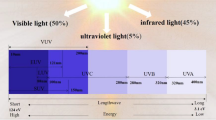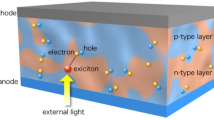Abstract
Interband cascade (IC) photovoltaic (PV) device structures, consisting of multiple discrete InAs/GaSb superlattice absorbers sandwiched between electron and hole barriers, were grown by molecular beam epitaxy. Details of the molecular beam epitaxy growth and material characterization of the structures are presented. The discrete absorber architecture enables certain advantages, such as high open-circuit voltage, high collection efficiency, high operating temperature, and smooth integration of cascade stages with different bandgaps. The two- and three-stage ICPV devices presented in this article operate at room temperature with substantial open-circuit voltages at a cutoff wavelength of 5.3 μm (corresponding to a bandgap of 0.23 eV), the longest ever reported for room temperature PV devices. The device characteristics indicate a high level of current matching and demonstrate the advantages of the interband cascade approach in thermophotovoltaic cell design.







Similar content being viewed by others
References
Wilt D, Chubb D, Wolford D et al (2007) Thermophotovoltaics for space power applications. In: Proceedings of seventh world conference on thermophotovoltaic generation of electricity, vol 890. American Institute of Physics, College Park, pp 335–345
Teofilo VL, Choong P, Chang J et al (2008) Thermophotovoltaic energy conversion for space. J Phys Chem C 112:7841–7845
Datas A, Algora C (2013) Global optimization of solar thermophotovoltaic systems. Prog Photovolt Res Appl 21:1040–1055
Chan WR, Bermel P, Pilawa-Podgurski RCN et al (2013) Toward high-energy-density, high-efficiency, and moderate-temperature chip-scale thermophotovoltaics. Proc Natl Acad Sci USA 110:5309–5314
Coutts TJ, Ward JS (1999) Thermophotovoltaic and photovoltaic conversion at high-flux densities. IEEE Trans Electron Dev 46:2145–2153
Mauk MG, Andreev VM (2003) Gasb-related materials for TPV cells. Semicond Sci Technol 18:S191–S201
Zenker M, Heinzel A, Stollwerck G et al (2001) Efficiency and power density potential of combustion-driven thermophotovoltaic systems using GaSb photovoltaic cells. IEEE Trans Electron Dev 48:367–376
Su N, Fay P, Sinharoy S et al (2007) Characterization and modeling of InGaAs/InAsP thermophotovoltaic converters under high illumination intensities. J Appl Phys 101:064511
Yang RQ, Li L, Zhao L et al (2013) Recent progress in development of InAs-based interband cascade lasers. In: Belyanin AA, Smowton PM, eds Novel in-plane semiconductor lasers XII, Proc SPIE, vol 8640. SPIE Photonics West, San Francisco, p 86400q
Yang RQ (2013) Interband cascade (IC) lasers. In: Baranov A, Tournie E (eds) Semiconductor lasers: fundamentals and applications. Woodhead Publishing Limited, Cambridge
Yang RQ, Tian Z, Klem JF et al (2010) Interband cascade photovoltaic devices. Appl Phys Lett 96:063504
Lotfi H, Hinkey RT, Li L et al (2013) Narrow-bandgap photovoltaic devices operating at room temperature and above with high open-circuit voltage. Appl Phys Lett 102:211103
Hinkey RT, Tian Z-B, Rassel SMSS et al (2013) Interband cascade photovoltaic devices for conversion of mid-IR radiation. IEEE J Photovolt 3:745–752
Bracker AS, Yang MJ, Bennett BR et al (2000) Surface reconstruction phase diagrams for InAs, AlSb, and GaSb. J Cryst Growth 220:384–392
Tian Z, Hinkey RT, Yang RQ et al (2012) Interband cascade infrared photodetectors with enhanced electron barriers and p-type superlattice absorbers. J Appl Phys 111:024510
Keay JC, Li L, Brunski DB et al (2011) Suppression of slip-line defect formation in gasb substrates during thermal desorption of oxide layers. In: Poster session presented at 28th North American molecular beam epitaxy, San Diego
Acknowledgments
The authors are grateful to Yuchao Jiang, Lihua Zhao, Chao Niu, and Ernest S. Sanchez for technical assistance. This study was supported in part by the DoE EPSCoR program (DE-SC0004523) and C-SPIN, the Oklahoma/Arkansas MRSEC (DMR-0520550).
Author information
Authors and Affiliations
Corresponding authors
About this article
Cite this article
Ye, H., Lotfi, H., Li, L. et al. Multistage interband cascade photovoltaic devices with a bandgap of 0.23 eV operating above room temperature. Chin. Sci. Bull. 59, 950–955 (2014). https://doi.org/10.1007/s11434-014-0144-6
Received:
Accepted:
Published:
Issue Date:
DOI: https://doi.org/10.1007/s11434-014-0144-6




